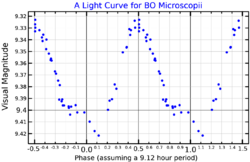Astronomy:BO Microscopii
| Observation data Equinox J2000.0]] (ICRS) | |
|---|---|
| Constellation | Microscopium |
| Right ascension | 20h 47m 45.00562s[2] |
| Declination | −36° 35′ 40.7698″[2] |
| Apparent magnitude (V) | 9.39[3] |
| Characteristics | |
| Spectral type | K3Ve[3] |
| Variable type | Flare star |
| Astrometry | |
| Radial velocity (Rv) | −5.64±2.03[2] km/s |
| Proper motion (μ) | RA: 18.735[2] mas/yr Dec.: −81.712[2] mas/yr |
| Parallax (π) | 19.5983 ± 0.5745[2] mas |
| Distance | 166 ± 5 ly (51 ± 1 pc) |
| Absolute magnitude (MV) | 5.92[4] |
| Details | |
| Mass | 0.82±0.08[5] M☉ |
| Radius | 1.06±0.04[5] R☉ |
| Temperature | 4750±50[6] K |
| Metallicity [Fe/H] | −1.49[4] dex |
| Rotation | 0.380±0.004 days[1] |
| Rotational velocity (v sin i) | 135[7] km/s |
| Age | 33±5[6] Myr |
| Other designations | |
| Database references | |
| SIMBAD | data |
BO Microscopii (BO Mic) is a star in the constellation Microscopium located about 170 light-years (52 parsecs; 11 million astronomical units) from the Sun. It has been dubbed "Speedy Mic" because of its very rapid rotation. The projected rotational velocity at the equator of this star is about 135 km/s (84 mi/s), which, with an estimated inclination of 70° to the line of sight from the Earth, means it completes a rotation every 0.380 ± 0.004 days (9.120 ± 0.096 hours). The photosphere of this star shows a high level of magnetic activity, with multiple star spots and prominences observed at the same time. As many as 25 prominences have been observed simultaneously, extending outward as far as 3.6 times the radius of the star. BO Mic is a flare star that undergoes sudden increases in X-ray and ultraviolet emissions. These events can emit a hundred times more energy than large solar flares.[7] Speedy Mic is one of the most active stars in the vicinity of the Sun.[5]
References
- ↑ 1.0 1.1 Cutispoto, G.; Kurster, M.; Pagano, I.; Rodono, M. (January 1997). "UBV(RI)c Photometry of the Rapidly Rotating K-Type Star HD197890 = "Speedy Mic"". Information Bulletin on Variable Stars 4419: 1. Bibcode: 1997IBVS.4419....1C. https://ui.adsabs.harvard.edu/abs/1997IBVS.4419....1C. Retrieved 28 January 2022.
- ↑ 2.0 2.1 2.2 2.3 2.4 Vallenari, A. et al. (2022). "Gaia Data Release 3. Summary of the content and survey properties". Astronomy & Astrophysics. doi:10.1051/0004-6361/202243940 Gaia DR3 record for this source at VizieR.
- ↑ 3.0 3.1 Torres, C. A. O. et al. (December 2006), "Search for associations containing young stars (SACY). I. Sample and searching method", Astronomy and Astrophysics 460 (3): 695–708, doi:10.1051/0004-6361:20065602, Bibcode: 2006A&A...460..695T
- ↑ 4.0 4.1 Holmberg, J.; Nordström, B.; Andersen, J. (July 2009), "The Geneva-Copenhagen survey of the solar neighbourhood. III. Improved distances, ages, and kinematics", Astronomy and Astrophysics 501 (3): 941–947, doi:10.1051/0004-6361/200811191, Bibcode: 2009A&A...501..941H
- ↑ 5.0 5.1 5.2 Dunstone, N. J. et al. (January 2006), "The coronal structure of Speedy Mic - I. A densely packed prominence system beyond corotation", Monthly Notices of the Royal Astronomical Society 365 (2): 530–538, doi:10.1111/j.1365-2966.2005.09729.x, Bibcode: 2006MNRAS.365..530D
- ↑ 6.0 6.1 Wolter, U. et al. (May 2005), "Doppler imaging of Speedy Mic using the VLT. Fast spot evolution on a young K-dwarf star", Astronomy and Astrophysics 435 (1): 261-273, doi:10.1051/0004-6361:20042239, Bibcode: 2005A&A...435..261W
- ↑ 7.0 7.1 Wolter, U. et al. (January 2008), "Doppler imaging an X-ray flare on the ultrafast rotator BO Mic. A contemporaneous multiwavelength study using XMM-Newton and VLT", Astronomy and Astrophysics 478 (1): L11–L14, doi:10.1051/0004-6361:20078838, Bibcode: 2008A&A...478L..11W
 |


